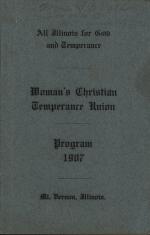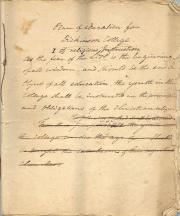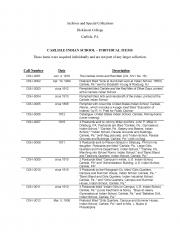A Pocketful of Rules, 1965-66

A Pocketful of Rules is produced by the Women’s Inter-Dormitory Council of Dickinson College. The guidebook contains a general summary of dormitory and campus procedures for female students.


A Pocketful of Rules is produced by the Women’s Inter-Dormitory Council of Dickinson College. The guidebook contains a general summary of dormitory and campus procedures for female students.

A Pocketful of Rules is produced by the Women’s Inter-Dormitory Council of Dickinson College. The guidebook contains a general summary of dormitory and campus procedures for female students.

A Pocketful of Rules is produced by the Women’s Inter-Dormitory Council of Dickinson College. The guidebook contains a general summary of dormitory and campus procedures for female students.

A Pocketful of Rules is produced by the Women’s Inter-Dormitory Council of Dickinson College. The guidebook contains a general summary of dormitory and campus procedures for female students.

Red Tape is produced by the Women’s Student Government at Dickinson College. The guidebook contains a general summary of dormitory and campus procedures for female students.

The Presidents Council of the Women’s Student Government at Dickinson College publishes Dickinson Data and Dormitory Life for the 1962-63 academic year.

This Woman’s Christian Temperance Union program from Mt. Vernon, Illinois contains psalms, a schedule of meetings, and a roster of the organization's officers and members.

A six page bibliography of 75 books written by Dr. Joseph Priestley.

The cover of a keepsake book produced for "Form and Content: The Art of the Book in the Pioneer Valley," an exhibition at the Northampton Center for the Arts including works by Weiss Prize recipient Leonard Baskin.

The Independent Theosophical League creates this pamphlet to outline policies and positions as well as discuss the reasons to form of an Independent Section of the Theosophical League.

Catalog for "Leonard Baskin in Massachusetts," an exhibition at the Museum of Fine Arts in Springfield, Massachusetts. Baskin received the Dickinson College Arts Award in 1963.

The collection consists of the papers of Charles Gilbert Beetem, a Carlisle, PA rug manufacturer, local historian and genealogist, amateur artist, and omnivorous collector. Diaries, manuscripts, letters, advertisements, greeting cards, and extensive runs of Philadelphia and Carlisle turn-of-the-century theater programs are all included in the collection, as well as accounts of Carlisle and Cumberland County history. College memorabilia includes his own drawings for Dickinson's yearbook. The collection also contains the Conodoquinet Yacht Club Archives. Miscellaneous materials include journals and accounts for homes he designed and built as well as those for proposed real estate development in Carlisle. The correspondence reflects Beetem's longtime interest in U. S. island possessions, which is the subject of his large collection of publications and books housed in our library.

The collection contains correspondence, pamphlets, and photographs of Dr. Annie (Wood) Besant (1847-1933), a prominent and revolutionary freethinker of the late nineteenth and early twentieth centuries. Besant was a Christian wife and mother who later in life became an Atheist doctor and activist. She became active in social reform after her children had been taken from her following her separation from her husband. In her later years Besant moved to India to help champion the cause of home rule in that country. The correspondence consists mainly of letters from Besant to her friends, family, and colleagues in the United States, England, and India. A particularly noteworthy letter is one written to Besant from Mohandas Gandhi. Also included in the collection are pamphlets written by Besant, a stamp from India dedicated to her honor, and several photographs of Besant.

The papers of the Board of Trustees of Dickinson College, 1783-1833, include correspondence, reports, financial statements, printed materials, and legal documents, and have been arranged into seven series.
Series 1 – Membership contains correspondence regarding membership on the Board of Trustees, as well as a membership list, c1826.
Series 2 – Reports of the President consists of reports made to the Board by Presidents Nisbet, Davidson, and How.
Series 3 – General Business contains materials such as correspondence between trustees, mandamus to the faculty, and committee reports.
Series 4 – College Personnel includes correspondence to and from faculty members, including presidents.
Series 5 – Physical Plant contains land deeds and construction and service bills for the campus buildings.
Series 6 – Financial Affairs contains reports of the treasurer, subscription lists, and other financial materials.
Series 7– Publications contains printed materials such as college catalogues.
A fuller description of each series is given before each series inventory.

The collection contains materials relating to family life on the Eastern Shore of Maryland and in Ohio. The central figure is Daniel Bowdle (1796-1876), who as a young man moved to Cincinnati and became the successful business man of his family, with real estate and other interests. He aided his less fortunate kin in Talbot County, MD, including making provisions for the old age of James Lloyd, a beloved slave. The letters of William James Bowdle (1834-1876; Class of 1854) reflect student life at Dickinson College; letters of numerous other relatives are supplemented by genealogical notes on the Bowdle Family. Also included are papers on the settlement of the estate of Capt. Patrick Dickey, dated 1806-1841, which involve lands in Ohio and in Mason Co., VA.

The Robert Bridges Papers Collection provides insight into literary works of the late 19th and early 20th centuries, and reflects Bridges’ long period of work as an editor and literary critic. The collection spans a date range of 1875-1937, with large portions pertaining to the early 1890s and 1900s. The collection is divided into 16 series: Administrative Records, Editorial, Literary Reviews, Prose, Poetry, Drama, Addresses and Speeches, Other Writings, President Woodrow Wilson, Princeton University, Aldine Club, Personal, Images, Biographical Materials, Publications, Photographs, Oversized Photographs, and Artifacts.
A fuller description of each series is provided in the Collection Inventory.

James Buchanan was a graduate of Dickinson College, Class of 1809, who went on to become the fifteenth president of the United States. The majority of this collection is comprised of correspondence between Buchanan and his business and political associates; over four hundred letters penned by Buchanan are included in the collection. Drafts of speeches, printed pamphlets, and various memorabilia are also represented.

This collection contains a number of items purchased as a group from Robert Rowe in 2014, and features the business papers of Milton I. Zeigler, postcards, ephemera, and publications from the Carlisle Indian School. Zeigler served as the industrial instructor for the shoe and harness department at the Carlisle Indian School from about 1901-1909. His business papers include correspondence with government agents and material suppliers as well as vouchers for expenditures during various business trips. The postcards in this collection all feature images of the Carlisle Indian School. The ephemera in this collection include commencement programs and quotation cards printed by the Carlisle Indian School Press. The Publications section includes multiple government publications about the Carlisle Indian School as well as souvenir booklets about the school and a copy of Stiya: A Carlisle Indian Girl at Home, written by school matron and printing supervisor Marianna Burgess.
Most of the materials in this collection are available online at the Carlisle Indian School Digital Resource Center.

These items about the Carlisle Indian School were acquired by the Dickinson College Archives and Special Collections individually and are not part of any larger collection.

The Naomi Greensky Collection has been organized into two sections, Papers and Photographs. Most of the Papers can be categorized as ephemera and reflect extracurricular activities that Naomi participated in while at Carlisle. The papers include dance cards, holiday cards, a commencement program, and materials from Mercer Literary Society. There are also several calling cards or business cards from the Great Northern Railway and Glacier National Park. The Photographs include several postage-stamp sized images taken and developed at Carlisle Indian School’s Leupp Art Studio. The individuals pictured in the photographs are suspected to be students from the school, but most are unidentified. One young woman appears in six photographs – four as a young adult and two as a child – suggesting that she may be Naomi. A young man appears in three of the photographs, and it is likely that this young man is Naomi’s brother, Peter Greensky.

This collection contains a number of items purchased as a group from Robert Rowe in 2017, and includes a number of photographs, artifacts, and documents related to the Carlisle Indian School. The four court martials in this collection are from the year 1904, and include charges against a total of five students. The Ephemera and Publication sections include printed materials related to the Carlisle Indian School, including four schoolbooks used at the school in the 1910s. These books contain marginalia written by students. The photographs included in this collection include the E.A. Seabrook Photograph Album as well as a number of miscellaneous images. The artifacts in this section include a ceramic china dish and three brass buttons off of a school uniform.
Most of the materials in this collection are available online at the Carlisle Indian School Digital Resource Center.

Marcia Chamberlain was a friend and correspondent of poet Marianne Moore. This collection contains letters exchanged between the two women and other acquaintances, as well as a small amount of writings, photographs, and ephemera.

The Edwin K. Charles collection consists of the various papers, government documents, newsletters, transcripts, and publications collected by Charles in the years following the accident at Three Mile Island. Edwin K. Charles, a resident of Mechanicsburg, Pennsylvania, became heavily involved with the public-awareness group, Three Mile Island Alert, directly following the accident at Three Mile Island in 1979. Over the years, he collected various materials concerning the legal struggles between the NRC, GPU, and Three Mile Island Alert.

Charles Collins (1813-1875) was a native of Maine and a graduate of Wesleyan University (1837); he served as president of Emory and Henry College (1838-1852), of Dickinson College (1852-1860) and as proprietor and President of State Female College in Memphis, Tenn. (1860-1875). The collection consists of correspondence, financial materials, literary materials, and printed materials. There are only minor amounts of correspondence, financial and printed materials. The bulk of the collection is the literary materials which include diaries, memoranda books, and compilations of sermons. The diaries cover Collins' spiritual life, his early presidency of Dickinson College, his decisions to leave Dickinson, and the effects of the Civil War in Memphis. The diary dated 1842-1874 has very scattered entries while the 1855-1872 diary contains copies of Collins' correspondence. Much of the financial material relates to Dickinson College, including two account books for subscriptions to the college and to a special telescope fund.
Three journals in this collection have been digitized and are available for reading online (see links for related entries below).

Moncure Daniel Conway was born into a southern aristocratic family, but ultimately became one of the nation's leading abolitionists and humanitarians. Conway was a graduate of Dickinson College in 1849 and was trained for the ministry at Harvard Divinity School. The collection consists mainly of correspondence relating to all phases of Conway's career; his student days at Dickinson and at Harvard, his anti-slavery witness, and his pastorate at South Place Chapel in London. His letters reflect his wide acquaintance with leading intellectual and political figures of his day; some of his correspondents include Ralph Waldo Emerson and Dr. Annie Besant.
The journal in this collection has been digitized and is available for reading online (see the link for related entries below).